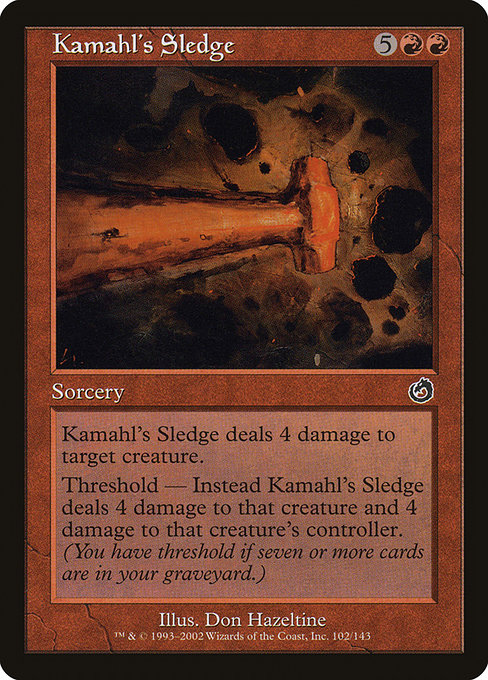
Image courtesy of Scryfall.com
Social dynamics shaping Kamahl's Sledge popularity
In the bustling ecosystem of MTG, popularity is rarely a purely mechanical result of stats and mana curves. It’s a living conversation, carried by streams, memes, and the casual night at a shop where a single card becomes a shared language. Kamahl's Sledge—a red sorcery from the Torment set—offers a revealing snapshot of how social dynamics lift certain cards into the limelight. A seven-mana sprint that hits hard, it delivers 4 damage to a target creature, and with Threshold it sprinkles a second punch: 4 more damage to that creature’s controller if seven or more cards are in your graveyard. The spell’s power escalates with the story players tell around it, and that story is as important as the digits on the card. 🧙♂️🔥
Community conversations around threshold-enabling cards tend to hinge on two things: how easily a deck can reliably reach the graveyard threshold, and how dramatically the card changes the table’s tempo when it lands. Kamahl's Sledge sits at an interesting crossroads. Its mana cost of {5}{R}{R} makes it a late-game finisher in a dedicated red shell, but in Commander or casual play, it often sneaks into teams that lean into graveyard shenanigans or mass-damage resilience. The rarity is common, yet it carries a certain nostalgia for older MTG players who remember the era when threshold was a sought-after mechanic that could turn a late-game draw into a narrative moment. Its art by Don Hazeltine—contained in Torment’s dark, early-2000s era—also anchors it in a memory-rich conversation about card design and flavor. 💎⚔️
From a social perspective, accessibility matters too. Kamahl's Sledge sits on the friendliest end of the spectrum in terms of price, which lowers barriers to entry and encourages casual experimentation. It’s not a powerhouse in the modern competitive scene, but it’s a card with high storytelling potential. When a deck operator posts a billowing, threshold-fueled moment on social media, fans don’t just see numbers—they see a moment of table politics, a swing in the social contract of the game. That’s where the currency of a card’s popularity often resides: in the stories and memories it helps create around the table. 🧙♂️🎨
“MTG is a game about people more than it’s a game about perfect mana curves.”
That sentiment helps explain why a common red spell can outlive more flashy staples: it becomes a catalyst for shared experiences. In the online space, enthusiasts will discuss how threshold is not merely a numeric condition but a signal of graveyard strategy realization. In stores and coffee-shop meta nights, Kamahl's Sledge becomes a talking point about risk tolerance, political play, and how to time a kill-steal moment when another player is about to stabilize. The net effect is a social halo around the card—people remember the moment it landed and the chaos that followed, more than the sum of its raw damage potential. 🧙♂️💥
Deck-building signals and strategy notes
For players crafting red-centric or graveyard-forward lists, Kamahl's Sledge is a reminder that damage spells can double as political tools. In a Commander setting, the threshold condition is particularly meaningful; it nudges players toward graveyard interactions—think cards that refill or mill, or ways to amplify graveyard value—without needing to overhaul an entire build. The social payoff is clear: a spell that interacts with the graveyard invites conversation about synergy, targets, and tempo, turning a straightforward burn spell into a focal point of group decision-making. ⚔️
Gameplay-wise, you’ll often see Kamahl's Sledge used in spots where the table is ready for a dramatic swing but where immediate removal options are scarce. The ability to threaten both the creature and its driver with one spell can redirect attention, forcing opponents to pivot from aggressive board pressure to defensive play. In casual circles, this creates memorable, shared expressions around the dining room table—moments that fans retell at conventions or in sleeves-worn anecdotes. The social gravity around the card, then, is as much about the memory it helps create as it is about the damage it delivers. 🧙♂️🔥
Art, lore, and the sense of history
Kamahl’s Sledge arrives in Torment’s dark, evocative frame, a reminder of MTG’s ongoing dialogue with its own lore and worldbuilding. The Kamahl character palette—barbed, volcanic red energy, and the brutal efficiency implied by a sledge—speaks to a type of player who cherishes big moments and big swings. The card’s flavor and design choices contribute to its social resonance because fans want to be part of a shared legend: the red spell that could swing a game when the graveyard grows fat with memories. It’s a little piece of the MTG history books that keeps resurfacing in discussion threads, league nights, and deck-building circles. 🎨💎
As a collectible, Kamahl's Sledge remains accessible for modern players who want to dip their toes into threshold psychology without breaking the bank. Its reappearance in different printings—foil and non-foil—mirrors the broader community’s interest in keeping classic designs alive, nurture nostalgia, and encourage experimentation in older formats. The social narrative around this card is a testament to how MTG’s community values both power and memory, drama and design. 🧙♂️
In the end, Kamahl’s Sledge is more than a spell; it’s a conversation starter. It invites players to explore how social dynamics—what creators say, what fans celebrate, and what shop-talk loves to dissect—shape what cards gain a following. And if you’re balancing your own collection or just looking for a stylish way to protect your daily carry, the rugged convenience of a sturdy phone case can be part of the ritual too. Speaking of which, consider pairing a rugged case with your next game night setup—because when the table erupts, you’ll want both your deck and your device standing tall. 🧙♂️💥
Rugged Phone CaseMore from our network
- https://blog.digital-vault.xyz/blog/post/blue-white-33k-k-giant-beyond-naked-eye-reach/
- https://transparent-paper.shop/blog/post/seamless-ai-chatbot-integration-for-marketing-campaigns/
- https://blog.zero-static.xyz/blog/post/armageddon-nostalgia-rekindling-mtg-bonds-and-battlefield-memories/
- https://blog.digital-vault.xyz/blog/post/luminous-blue-white-giant-glows-from-7800-light-years-away/
- https://blog.digital-vault.xyz/blog/post/design-thinking-for-product-creators-from-insight-to-impact/